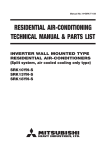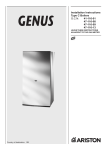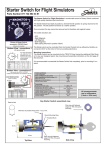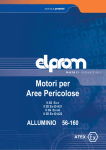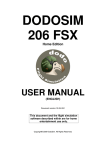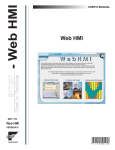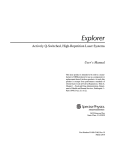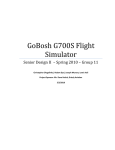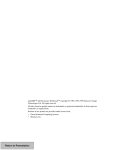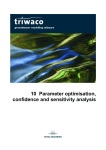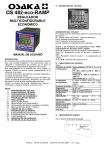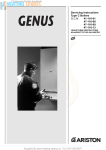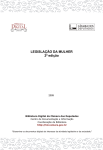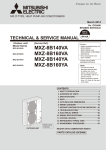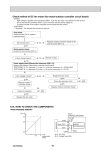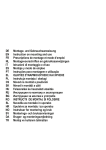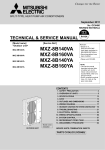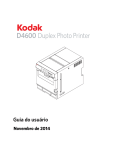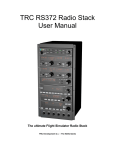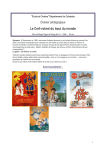Download The TRC Multi Controller USER MANUAL for connecting
Transcript
User Manual Multi Controller The TRC Multi Controller USER MANUAL for connecting Switches / Servos / LEDs Version 1.7 – 7 April 2009 The perfect controller board for building your cockpit Connect up to 736 hardware devices to Microsoft Flight Simulator using Multi Controllers and choose out of 1100 different instruments/indicators or other type of Input/Output devices ! Includes Project Magenta Codes Copyright TRC Development 2007 – version 1.6 – 5 November 2007 Page 1 User Manual Multi Controller Update from version 1.3 manual and software: - New calibration system (calibration points are given by user in floating point) - "Apply" button renamed to "Save calibration" - User will prompted when closing the application to confirm whether or not the calibration must be saved. - Fixed Stall Warning - Fixed Overspeed Warning - Added Engine 1 / 4 ITT in celcius and fahrenheir (see description below) - Added Cabin Temperature / Climb / Alt (see description below) TRC Type Description Code FSUIPC Code 443 S Turbine Engine 1 ITT (interstage turbine temperature) in degrees Celcius 2038 444 S Turbine Engine 1 ITT (interstage turbine temperature) in degrees Fahrenheit 2038 445 S Turbine Engine 2 ITT (interstage turbine temperature) in degrees Celcius 446 S Turbine Engine 2 ITT (interstage turbine temperature) in degrees Fahrenheit 2138 447 S Turbine Engine 3 ITT (interstage turbine temperature) in degrees Celcius 448 S Turbine Engine 3 ITT (interstage turbine temperature) in degrees Fahrenheit 2238 449 S Turbine Engine 4 ITT (interstage turbine temperature) in degrees Celcius 450 S Turbine Engine 4 ITT (interstage turbine temperature) in degrees Fahrenheit 2338 904 S Cabin Temperature (factor 0.1) 567E 905 S Cabin Climb (factor 10) 56A4 906 S Cabin Alt (factor 10) 56A6 2138 2238 2338 Update from version 1.4 manual and software: TRC Type Code Description FSUIPC Code 907 S APU-EGT 5604 908 S BleedPSI1 (Duct Press 1) 567A 909 S BleedPSI2 (Duct Press 2) 567C 910 S CabinDiffPress 56B8 Copyright TRC Development 2007 – version 1.6 – 5 November 2007 Page 2 User Manual Multi Controller Contents 1. TRC programmable Multi Controller .................................................................................................. 5 2. The control software .......................................................................................................................... 8 C. The Multi Controller driver software mclink.exe............................................................................. 9 3. Installing the software ...................................................................................................................... 10 4. Connecting the Multi Controller to your PC for the first time ........................................................... 13 5. Using the Multi Controller “Number Assign” program: mcnum.exe. ................................................ 15 Step 4 – IMPORTANT! ..................................................................................................................... 16 6. About the I/O line assign and calibration software (mccal.exe) ...................................................... 17 PM codes * ....................................................................................................................................... 17 7. Using the I/O assign and calibration software mccal.exe................................................................ 18 WARNING ! ! ! ..................................................................................................................................... 20 8. Calibration of connected Gauges (servos) ...................................................................................... 21 Example 1: Calibrating a Vertical Speed Indicator .......................................................................... 22 Example 2: Calibrating a 450 knots Airspeed Indicator .................................................................. 23 Example 3: calibrating a Flaps Indicator ......................................................................................... 24 9. Using the MC Link program ............................................................................................................. 25 10. Table of I/O possibilities based on FSUIPC codes ....................................................................... 26 11. Table of I/O possibilities based on Project Magenta codes – table 1 ........................................... 36 12. Table of I/O possibilities based on Project Magenta codes / Table 2 ........................................... 43 13. How to connect instruments to the I/O lines of the Multi Controller .............................................. 53 14. Hardware pin assignment of the Multi Controller .......................................................................... 54 15. How to connect Switches, LED’s and Gauges (Servos) correctly ................................................ 54 16. Schematics .................................................................................................................................... 55 17. Multi Controller Connector Table ................................................................................................... 57 18. Available expansion boards for the Multi Controller ...................................................................... 58 The “Screw Terminal” expansion board ................................... Fout! Bladwijzer niet gedefinieerd. 19. Additional important information .................................................................................................... 59 Important: Please read the remark on assigning a sequence number to the Multi Controller in Chapter 3 and 5 prior to connecting any Multi Controller to your USB port!!! This manual and the software to control the Multi Controller are copyrighted by TRC Development b.v. Nothing from this manual may be used, published or otherwise copied without prior written approval from TRC Development b.v. – The Netherlands. Copyright TRC Development 2007 – version 1.6 – 5 November 2007 Page 3 User Manual Multi Controller Original Publish date: August 1, 2005 Copyright TRC Development 2007 – version 1.6 – 5 November 2007 Page 4 User Manual Multi Controller 1. TRC programmable Multi Controller No programming knowledge necessary! The TRC programmable “Plug-and-Play” Multi Controller is a USB connected I/O board offering 23 Input/Output lines. Each I/O line is capable of a.) driving an LED (Light Emitting Diode, max. 20 mA), b.) driving a servo motor, or c.) reading the position of a switch. You choose the function of each I/O line. Each line contains three connectors (input connector, output connector and servo connector). These lines may be used to control many different flight simulator functions. The Multi Controller can control single or dual pointer gauges. It cannot control gauges which need to feed back positioning signals to the controller, like the Altimeter, Heading Indicator, VOR1/2, ADF or Wet Compass. Therefore you need to use a CCU or SIC board. When using already a CCU or SIC, you can use Multi Controller(s) to expand your cockpit to even a 6 engine aircraft with many, many additional gauges, switches or LED signals. The Multi Controller software (included with the controller board) uses the I/O system from the FSUIPC software (written by Pete Dowson) to connect to Microsoft Flight Simulator. This PC compatible software is capable of recognizing up to 32 Multi Controllers connected to the PC via a single USB cable, thereby creating the most advanced control system for flight simulation ever (multiple USB devices can be connected by daisy chaining USB hubs). The version 1.3 release of the Multi Controller software does support Project Magenta (see www.projectmagenta.com) codes (see tables). Note: A separate license is required in order to use FSUIPC software to connect MS Flight Simulator to Project Magenta. Contact www.schiratti.com/dowson.html to obtain the necessary license. No programming knowledge is required. To assign an instrument or a function to an Input/Output line, merely select the instrument or function from a list of over 250 possibilities! You may assign one I/O line drive an LED, another to drive a servo motor on a SimKits instrument, and a third to read the position of a switch. You have unlimited possibilities with the new TRC programmable Multi Controller. By adding one or more inexpensive USB hubs to your PC, you may connect up to 32 of these controllers to your PC. This will allow the connection of up to 736 instruments, 736 switches, 736 LED’s Copyright TRC Development 2007 – version 1.6 – 5 November 2007 Page 5 User Manual Multi Controller (outputs) to your PC (or a combination thereof), thus allowing nearly limitless possibilities in simulator configuration! The TRC programmable Multi Controller uses the same proven technical architecture as the Central Control Unit (CCU), and may be the ultimate solution for designing your cockpit! To drive servos or multiple LED’s, you will need to connect a standard PC power supply to the power connector on the board. Should you use the board to “read” inputs only (like switches), the power supplied via the USB cable is sufficient, since this drives the electronics on the board only. You can connect a maximum of 23 different instruments to each Multi Controller (one per I/O line). Note: If using multiple “daisy chained” hubs, it is highly recommended to use powered hubs, since the output of a PC can normally deliver a maximum of 500mA. For example, should you use a single Multi Controller and assign all the outputs to drive LED’s (20mA each), power consumption from the USB is approximately 480mA when a separate power supply is not used. This is approximately the maximum output available from a USB connection. However, if you connect an external PC power supply to the Multi Controller and configure the jumpers so that this external power is used to drive the LED’s etc., you will not need powered hubs when connecting only a few (up to 10) Multi Controllers. OUTPUT Each I/O line can be configured as an Output. You can connect an LED to this line via a current limiting resistor, or you may connect a small relay to drive heavier electric loads. The maximum current output per I/O line is 20mA. An LED in combination with a current limiting resistor uses less than 20mA. Note: The current limiting resistor is already mounted on the Multi Controller. Then by using the included software, you assign this output of the Multi Controller to a certain function in Microsoft Flight Simulator (ie. panel lights). INPUT Each I/O line can also be configured as an Input. You can then connect one side of a switch to this I/O line and connect the other side of the switch to ground (available on the I/O connector). Then by again using the included software, you assign this switch to a function in Microsoft Flight Simulator (ie. avionics on/off). Copyright TRC Development 2007 – version 1.6 – 5 November 2007 Page 6 User Manual Multi Controller SERVO Each I/O line can also be configured to drive a servo to control a pointer on an instrument, such as the needle on the manifold pressure gage. You will need to connect a standard PC power supply to the Multi Controller board and place a jumper into the correct position (see block schematics) in order to feed this external power to the servo. The software used to control the setting of the TRC programmable Multi Controller has an easy “click and assign” interface. This enables you – without programming knowledge – to assign the function of each I/O line to an instrument or other function within Microsoft Flight Simulator via the FSUIPC interface software. Copyright TRC Development 2007 – version 1.6 – 5 November 2007 Page 7 User Manual Multi Controller 2. The control software To use the Multi Controller board and to assign a certain I/O line to a function in Microsoft Flight Simulator, no programming knowledge is necessary. All configurations are “Click-and-Assign”. The Multi Controller software uses FSUIPC to connect to Microsoft Flight Simulator. This program can be downloaded from the website http://www.schiratti.com/dowson.html. The FSUIPC installation documentation and users manual may be downloaded from this site, also. The Multi Controller needs three (3) different software programs to function: A. The Multi Controller “number assign” program: mcnum.exe B. The I/O assign and calibration software: mccal.exe C. The Multi Controller Driver software: mclink.exe A. The Multi Controller “number assign” program mcnum.exe The first activity is to assign an identity to each Multi Controller card. This number is “programmed” once into an on-board EEPROM (electrically erasable programmable ROM), and will remain there unless you use the software again to re-program the number. Therefore, this software is normally only used once to initially identify each Multi Controller. Note: Each Multi Controller comes from the factory assigned as a “number 1 device”, and multiple controllers must be renumbered. Very Important: When connecting a Multi Controller to your PC to be renumbered, this must be the only controller connected at this time. Otherwise the mcnum.exe program isn’t able to distinguish which controller you wish to re-number! So therefore disconnect any Simkits USB devices like the CCU, SIC, Radio Stack Controller or other Multi Controllers before you start the mcnum.exe program!! Once this unique number/identification is assigned to the Multi Controller, the driver software will recognize it. If using only one Multi Controller, you don’t have to assign a number to the board, although you may wish to do so to become familiar with the mcnum.exe software. The Multi Controller may be connected either directly to a USB port on your computer or through a USB hub, which may be purchased from the SimKits website or from a local computer shop. Copyright TRC Development 2007 – version 1.6 – 5 November 2007 Page 8 User Manual Multi Controller As each Multi Controller requires only 50mA to function, many boards may be connected to a single USB port by using non-powered hubs. However, if powering a multitude of LED’s and servos, it is recommended to use a PC power supply so as to not overload the USB source. B. The I/O assign and calibration software mccal.exe With the Multi Controller board(s) connected to your PC and the “assign and calibration” software installed, you may begin assigning each I/O line to a certain function in Microsoft Flight Simulator or to Project Magenta. Complete instructions on how to assign and calibrate the instruments connected to a Multi Controller are found in Chapter 5. C. The Multi Controller driver software mclink.exe This software connects to Microsoft Flight Simulator via the FSUIPC software from Pete Dowson (see www.schiratti.com/dowson.html for more information). You will need FSUIPC version 3.xx or later. The mclink.exe software uses the data produced by the mccal.exe software to control each I/O line and the function assigned to it. Note: When the mclink.exe program is running, the mcnum.exe and mccal.exe programs should be closed. Copyright TRC Development 2007 – version 1.6 – 5 November 2007 Page 9 User Manual Multi Controller 3. Installing the software Note: Do not connect the Multi Controller(s) to your PC yet. In order to download the required files, you must first create a directory in which to store the files (such as a directory named “Multicontroller”). Then download the file “Multicontroller.zip” from the Simkits website [email protected] and unzip the file into this directory. Verify that you are downloading the latest version of the software, and periodically go to the website and download any updates that may be available. The zip file contains the following files: Setup.exe trcmc.inf trcdrv.sys Close all open programs and start the program Setup.exe. Now follow the on-screen directions to install the software program. Copyright TRC Development 2007 – version 1.6 – 5 November 2007 Page 10 User Manual Multi Controller If you agree with the directory chosen by the software installation program, just click “Next”. Otherwise, browse for a new directory of your choice. (The list of “Existing Folders” on the left is only an example, and is different from the list that will be seen on your computer!) Copyright TRC Development 2007 – version 1.6 – 5 November 2007 Page 11 User Manual Multi Controller When the installation is done, click “Finish” to restart your computer. This will save the new settings. Copyright TRC Development 2007 – version 1.6 – 5 November 2007 Page 12 User Manual Multi Controller 4. Connecting the Multi Controller to your PC for the first time Once you have installed the Multi Controller software, you may now connect the Multi Controller board(s) to your PC using the included USB cable. Your PC will recognize the Multi Controller as a new device and the following screens will be shown: Select “No, not this time” and click “Next”. Now click on the option “Install from a specific location (Advanced)” and click “Next”. Use the “Browse” option and choose the directory into which you unzipped the downloaded software. This directory should contain the files “trcdrv.sys” and “trcmc.inf”. Now click “Next”. Copyright TRC Development 2007 – version 1.6 – 5 November 2007 Page 13 User Manual Multi Controller The “Found New Hardware Wizard” will start installing the driver software. This process may take several minutes. While the software is installing the driver, you will see the progress of the installation in the window on the screen. Once the driver is installed, press the “Finish” button to finalize the installation. Your PC may ask for a restart. If it does, restart your PC. Then follow the directions in the next Chapter. Copyright TRC Development 2007 – version 1.6 – 5 November 2007 Page 14 User Manual Multi Controller 5. Using the Multi Controller “Number Assign” program: mcnum.exe. The Multi Controller is delivered from the factory with the internal number set to 1. This means that should you have more than one Multi Controller connected to your PC, they would all look the same to your PC, and the software would not be able to recognize them from each other. Therefore, TRC has developed the “Number Assign” program, called mcnum.exe. This program allows you to assign a number (from 1 to 32) to each Multi Controller. Very Important: When connecting a Multi Controller to your PC to be renumbered, this must be the only controller connected at this time. Otherwise the mcnum.exe program isn’t able to distinguish which controller you wish to re-number! So therefore disconnect any Simkits USB devices like the CCU, SIC, Radio Stack Controller or other Multi Controllers before you start the mcnum.exe program!! Step 1 Disconnect all Multi Controllers from your PC except the one you are renumbering. Step 2 Start the Multi Controller number assign program mcnum.exe. The following screen is shown: Step 3 Arrow down to the number you would like to assign to this specific Multi Controller board and press “Program”. You will automatically be asked to “verify” your selection, which will result in a message being displayed in the lower part of the window informing you about the results of the program action. Copyright TRC Development 2007 – version 1.6 – 5 November 2007 Page 15 User Manual Multi Controller To verify that the number has been correctly assigned to the Multi Controller, connect the controller to your PC (note: only 1 at a time) and press “Verify”. This will result in a message in the lower part of the screen informing you which number has been programmed into this particular controller Note: the field Multi Controller ID does not necessarily tell you the correct number of the Multi Controller when using the “verify” function, only the status line does! Step 4 – IMPORTANT! You must now temporarily disconnect the USB cable from the Multi Controller. Otherwise, your PC will not recognize the newly assigned number, and will be looking for the old number that was assigned to the controller prior to programming the new identity. Just unplug the USB cable, wait 5 seconds and plug it in again. Your PC will now recognize the controller as a new device. Once the PC has recognized the new device, you can use it with the I/O assign and calibration software: mccal.exe. Copyright TRC Development 2007 – version 1.6 – 5 November 2007 Page 16 User Manual Multi Controller 6. About the I/O line assign and calibration software (mccal.exe) This software program finally connects the Multi Controller to Microsoft Flight Simulator. As mentioned previously, you will also need the latest version of the FSUIPC software to control the standard list of instruments that are currently available to Microsoft Flight Simulator and/or Project Magenta, as well as to control additional instruments as they become available. For more information on the FSUIPC software, please consult www.schiratti.com/dowson.html. The following list of codes depicts the general numbering system assigned to the I/O lines. The first groups of codes are FSUIPC (Flight Simulator) codes, while the second group is for Project Magenta. Please note: The numbers used by the Multi Controller software are not necessarily identical to the FSUIPC or Project Magenta codes. Each function has been assigned a unique number for ease of assigning functions. FSUIPC codes The numbers 100 through 199 are reserved for Inputs The numbers 200 through 299 are reserved for Outputs The numbers 300 through 399 are reserved for Servos (gauges) PM codes * The numbers 600 through 799 are reserved for Inputs The numbers 800 through 899 are reserved for Outputs The numbers 900 through 999 are reserved for Servos (gauges) Copyright TRC Development 2007 – version 1.6 – 5 November 2007 Page 17 User Manual Multi Controller 7. Using the I/O assign and calibration software mccal.exe Even though you may have previously connected a Multi Controller to your PC, after using the Number Assign program (mcnum.exe), the identification of the Multi Controller has been changed and is therefore viewed as a new item to your PC. You may need to repeat the steps in Chapter 4 to correct any errors in assignments. When you use a new Multi Controller for the first time with the I/O assign and calibration software, there are no functions assigned to any of the I/O lines. With a previously used controller, the chart will show all assigned functions in their specific fields. If you are not satisfied with the assignment of an I/O line or the response of a gauge, you may wish to run the mccal.exe software program again. Only the latest changes produced by running mccal.exe are saved into the parameter files. See the following pages for directions on using the mccal.exe program. Copyright TRC Development 2007 – version 1.6 – 5 November 2007 Page 18 User Manual Multi Controller Multi Controller Calibration Centre The Multi Controller field identifies the Multi Controller you are working on. If the dropdown list doesn’t show the number of a particular controller, then the mccal.exe software has not recognized that controller. Address Enter the number of the desired function from the list of possible I/O functions (in the column TRC#) The mccal.exe program recognizes the type of function you have chosen and enters it for you. Type Here the mccal.exe program displays the type of function you have chosen: Servo to drive a gauge, Input to read from a switch and Output to drive an LED or other device. Function Short description of the function that is assigned to this I/O line. Calibrate Press this button (when available) to calibrate the gauge. Save Calibration Press this button to save the settings. Up to 23 I/O lines per Multi Controller The fields are numbered from 1 to 23. By entering the appropriate number from the list from Chapter 10 or 11, you have assigned a certain function to that I/O line of the Multi Controller. When the function is an Output, you don’t have to do anything anymore to complete this function. The output will respond to the high or low signal from Microsoft Flight Simulator or from Project Magenta. An LED can be directly connected to the I/O line, which may draw a maximum of 20mA. A current limiting resistor has been placed on the Multi Controller to prevent drawing excessive current. A DIL relay operating at 5V, 20mA may be connected to switch heavier loads. See technical details in Chapters 12 through 16 for connecting LED’s. Copyright TRC Development 2007 – version 1.6 – 5 November 2007 Page 19 User Manual Multi Controller When the function is an Input, connect a switch or a pushbutton to this I/O line. Closing the switch will cause the input to be recognized by Microsoft Flight Simulator or to Project Magenta. See technical details in Chapters 12 to 16 for connecting switches. When the function is a Servo, you need to connect a gauge with a servo to this I/O line. The “Calibrate” button now becomes active, and you can calibrate the gauge as described on the following pages. See technical details in Chapters 12 to 16 for connecting servos. And don’t forget to connect an external power supply to the Multi Controller to drive the servos! WARNING ! ! ! When the calibration is started for the first time for a Multi Controller Board which you have not used to calibrate earlier (you clicked on the button “Calibrate”), the Multi Controller is recognized as a new USB device. Therefore you must follow once again the steps as described in Chapter 4 on page 10 and 11. Fail to do so, will cause that you cannot use the Multi Controller as you wish. This extra USB installation/identification towards Windows is only necessary once. Copyright TRC Development 2007 – version 1.6 – 5 November 2007 Page 20 User Manual Multi Controller 8. Calibration of connected Gauges (servos) Since servo motors are used in the gauges, they each need to be calibrated once before using them with Microsoft Flight Simulator, because most of the face plate scales used in aircraft are non-linear. Therefore, the software must “learn” about the scale being used, and will save the created data into a file. The file data is used by the program mclink.exe, which controls the instrument connected to the I/O line. Needless to say, you must have a gauge connected to this I/O line. The first step of the calibration By clicking on the calibration button in the previous screen, you entered the calibration routine for a certain instrument. Function Here the TRC number selected from the list is shown again for security. Also, the function description is show again. Initiate the values The screen shows 10 input fields and 10 sliders, each numbere from “Step 1” to “Step 10”. Here you have to enter the values you see on the faceplate of the gauge. In case there are less than 10 values on the gauge faceplate, you need to devide the faceplate into imaginary values. For example, your faceplate only shows 10, 30, 50, 70, 90, you need to find out where values 0, 20, 40, 60 and 80 would be. Now you enter the value “0” (zero) in the first field, 20 in the second field, 30 in the third field and so on. It might be necessary to do some calculations here when you have a faceplate which has a non-linear scale other than a linear scale. Some try and error will help you to get there! In case your scale calculation doesn’t come out to exactly 10 values, you may use a value double. Fore xample when the last value is 100 and you have reached that value in field 9, you may enter the value 100 also in field 10. Note When you want to calibrate a gauge like a Vertical Speed Indicator, you will need to enter negative values (for example -20, -15, -10, -5, 0, 0, 5, 10, 15, 20) Copyright TRC Development 2007 – version 1.6 – 5 November 2007 Page 21 User Manual Multi Controller Example 1: Calibrating a Vertical Speed Indicator When calibrating a vertical speed indicator, you need to enter negative as well as positive values in the Value Fields. Always start to calibrate clockwise. This means that you must enter the lowest (or most negative) value in the first field and then the next higher (or less negative) value in the subsequent fields. Prior to entering these values, you should check whether you come to an odd or even amount of values. In case (as with the VSI) the number of values are odd, you need to enter a certain value twice. In this case the value “0” (zero) needs to be entered twice. Now use the slider to calibrate the pointer exactly to the position as in the value field given. For the zero value (entered twice) you have to set the pointer indeed for both “zeros”, precisely at “0”. Important: During calibration, the pointer must always be set clockwise to a new position. Moving the pointer from –20 to +20 the shortest way will give a wrong calibration! When constructin a kit gauge, you should always be sure that the pointer can reach all positions on the faceplate and has some “spare” available on both ends of the scale. I Copyright TRC Development 2007 – version 1.6 – 5 November 2007 Page 22 User Manual Multi Controller Example 2: Calibrating a 450 knots Airspeed Indicator This example uses a 450 knots Airspeed indicator scale as used in an Airliner. The Airliner ASI scale is partly linear and partly non-linear. Therefore you can set the calibration values for the linear part of the scale in such a way, that the values are in larger steps than the non-linear part. This example has set the values in such a way, that a proper division between the linear and non-linear values gives the best results. These values are: 0, 70, 100, 130, 170, 210, 240, 250, 300, 400. Important: During calibration, the pointer must always be set clockwise to a new position. Moving the pointer from 0 to 400 the shortest way will give a wrong calibration! When constructin a kit gauge, you should always be sure that the pointer can reach all positions on the faceplate and has some “spare” available on both ends of the scale. Copyright TRC Development 2007 – version 1.6 – 5 November 2007 Page 23 User Manual Multi Controller Example 3: calibrating a Flaps Indicator This example uses a Flaps indicator scale as used in an Airliner . As the calibration is based on dividing the scale of the gauge into the proper values which come from the flight simulator software, first you have to divide the scale (faceplate) of the gauge into sections from 0 to 100%. The scale has the following values: UP (0), 1, 2, 5, 10, 15, 25, 30, 40 As the full path of the pointer - from UP(0) to 40 - has to be divided on the scale as from 0 to 100%, the following table is created: Scale values % of scale UP(0) 0 1 2.5 2 5 5 7.5 10 25 15 37.5 25 62.5 30 75 40 100 Since the calibration table cannot handle fractions, the values behind the decimal point are rounded off. Since there are only 9 values, the last value is repeated in step 10 (100 entered) The calibration has to be carried out for each individual pointer. Copyright TRC Development 2007 – version 1.6 – 5 November 2007 Page 24 User Manual Multi Controller 9. Using the MC Link program Once you have “identified” the Multi Controller board using the mcnum program (you should always assign a number to a Multi Controller, even if using only one) and once you have properly calibrated each controller you have connected, you can use the program mclink to “connect” the hardware (via FSUIPC) to Microsoft Flight Simulator. As a reminder, the use of the Multi Controller requires three programs: first, the mcnum.exe program to assign a number to the Multi Contoller; second, the mccal.exe program to assign the proper instrument to the Multi Controller and to calibrate it (calibration only needed for gauges), and third, the mclink.exe program to “connect” the hardware via FSUIPC to Microsoft Flight Simulator. For each Multi Controller connected to your PC, you have to run the mclink.exe program. For example, when you have three Multi Controllers connected via USB to your computer, you should run the mclink.exe program three times. However, there will be a different number in the number field each time. In the example shown, the program shows number 1 in the entry field. The next running of the program should show a different number. You can assign and start up to 32 Multi Controllers this way. The actual order you use doesn’t matter as long as you run the program for each Multi Controllers connected to your PC. Message The MC Link window also tells you when the Flight Simulator software is connected, when the Multi Controller is connected, or when the ID is already occupied. The MC Link ID field always defaults to the number one (1). Therefore, if you have previously connected a Multi Controller with an MCLink, at the startup of the next one, the message “Already Occupied” will be displayed, meaning that you have to select a different number. The possible messages are: “Already Occupied” (when number 1, for example, is already in use) “Not Connected” (when for any reason the software cannot connect to a Multi Controller) “Connected” (when the software is properly connected to a Multi Controller). Copyright TRC Development 2007 – version 1.6 – 5 November 2007 Page 25 User Manual Multi Controller - - Alternator (1 = on, 0 = off), read for state, write to FSUIPC # Description Functional Units - Value Minimum I Maximum Type 101 Value TRC # 10. Table of I/O possibilities based on FSUIPC codes 3101 control [FS2000+] 102 I - - - Avionics (1 = on, 0 = off), read for state, write to 3103 control [FS2000+] 103 I - - - Battery (1 = on, 0 = off), read for state, write to 3102 control [FS2000+] 104 I - - - Rotating Beacon 0D0C 105 I - - - Cabin Lights 0D0C 106 I - - - Engine 1 Anti-Ice or Carb Heat switch (1=On) 08B2 107 I - - - Engine 1 Fuel Valve, 1 = open, 2 = closed. Can write 3590 108 I - - - 109 I - - - Engine 1 Magnetos (Both) 0892 110 I - - - Engine 1 Magnetos (Left) 0892 111 I - - - Engine 1 Magnetos (Right) 0892 112 I - - - Engine 1 Magnetos (Start) 0892 113 I - - - Engine 2 Anti-Ice or Carb Heat switch (1=On) 094A 114 I - - - Engine 2 Fuel Valve, 1 = open, 2 = closed. Can write 3594 115 I - - - 116 I - - - Engine 2 Magnetos (Both) 117 I - - - Engine 2 Magnetos (Left) 092A 118 I - - - Engine 2 Magnetos (Right) 092A 119 I - - - Engine 2 Magnetos (Start) 092A 120 I - - - Engine 3 Anti-Ice or Carb Heat switch (1=On) 0900 121 I - - - Engine 3 Fuel Valve, 1 = open, 2 = closed. Can write 3598 122 I - - - 123 I - - - Engine 3 Magnetos (Both) 09C2 124 I - - - Engine 3 Magnetos (Left) 09C2 125 I - - - Engine 3 Magnetos (Right) 09C2 126 I - - - Engine 3 Magnetos (Start) 09C2 127 I - - - Engine 4 Anti-Ice or Carb Heat switch (1=On) 0A7A 128 I - - - Engine 4 Fuel Valve, 1 = open, 2 = closed. Can write 359C to operate. [FS2002+] Engine 1 generator switch, a 32-bit BOOL (0 = off, 3B78 1= on) [FS2000-FS2004 only] to operate. [FS2002+] Engine 2 generator switch, a 32-bit BOOL (0 = off, 3AB8 1= on) [FS2000-FS2004 only] 092A to operate. [FS2002+] Engine 3 generator switch, a 32-bit BOOL (0 = off, 39F8 1= on) [FS2000-FS2004 only] to operate. [FS2002+] Copyright TRC Development 2007 – version 1.6 – 5 November 2007 Page 26 - - Engine 4 generator switch, a 32-bit BOOL (0 = off, FSUIPC # Description Functional Units - Value Minimum I Maximum Type 129 Value TRC # User Manual Multi Controller 3938 1= on) [FS2000-FS2004 only] 130 I - - - Engine 4 Magnetos (Both) 0A5A 131 I - - - Engine 4 Magnetos (Left) 0A5A 132 I - - - Engine 4 Magnetos (Right) 0A5A 133 I - - - Engine 4 Magnetos (Start) 0A5A 134 I - - - Engine primer (just write a non-zero byte to operate 3100 the primer. This is a one-shot and reading it is meaningless) [FS2000+] 135 I - - - Fail mode: 0 ok, Engine inoperable = 1, extended for 0B6B FS2000/CFS2 for up to 4 individual engines: bit 0 =Engine 1 ... bit 3= Engine 4. (but note that this may not work for FS98 aircraft transposed into FS2k/CFS2). 136 I - - - Fail mode: ADF 0B64 137 I - - - Fail mode: Altimeter 0B66 138 I - - - Fail mode: ASI 0B65 139 I - - - Fail mode: Attitude Indicator 0B67 140 I - - - Fail mode: COM1 radio 0B68 141 I - - - Fail mode: Direction Indicator 0B6D 142 I - - - Fail mode: Electronics 0B6A 143 I - - - Fail mode: Fuel indicators 0B6C 144 I - - - Fail mode: Mag Compass 0B69 145 I - - - Fail mode: NAV radios 0B70 - - 146 I - 147 I - 148 I - 149 I - - - Fail mode: Pitot 0B71 Fail mode: Transponder 0B6F Fail mode: Turn co-ordinator 0B72 Fail mode: Vacuum 0B73 150 I - - - Fail mode: VSI 0B6E 151 I - - - Fuel pump (1 = on, 0 = off), read for state, write to 3104 control [FS2000+]. For separate switches for separate fuel pumps see offset 3125. 152 I - - - Fuel tank selector: All 0AF8 153 I - - - Fuel tank selector: Centre 0AF8 154 I - - - Fuel tank selector: Centre 2 0AF8 155 I - - - Fuel tank selector: Centre 3 0AF8 156 I - - - Fuel tank selector: Crossfeed LtoR 0AF8 157 I - - - Fuel tank selector: Crossfeed RtoL 0AF8 158 I - - - Fuel tank selector: External 1 0AF8 159 I - - - Fuel tank selector: External 2 0AF8 160 I - - - Fuel tank selector: Left 0AF8 161 I - - - Fuel tank selector: Left Tip 0AF8 Copyright TRC Development 2007 – version 1.6 – 5 November 2007 Page 27 FSUIPC # Description Functional Units Value Maximum Value Minimum Type TRC # User Manual Multi Controller 162 I - - - Fuel tank selector: Left Aux 0AF8 163 I - - - Fuel tank selector: Right 0AF8 164 I - - - Fuel tank selector: Right Tip 0AF8 165 I - - - Fuel tank selector: Right Aux 0AF8 166 I - - - Gear control 0BE8 167 I - - - Instruments 0D0C 168 I - - - Landing Light 0D0C 169 I - - - Logo 0D0C NAV/GPS switch, in FS2000 & FS2002. 0=NAV, 132C 170 I - - - 171 I - - - 172 I - - - 173 I - - - 174 I - - - 175 I - - - 176 I - - - 177 I - - - 178 I - - - Panel auto-feather arm switch (0=Off, 1=On) 179 I - - - Parking brake 0BC8 180 I - - - Pause MS-Flightsimulator 0262 1=GPS Navigation Lights PANEL AUTOBRAKE SWITCH Read to check setting, write to change it. Brake1 PANEL AUTOBRAKE SWITCH Read to check setting, write to change it. Brake2 PANEL AUTOBRAKE SWITCH Read to check setting, write to change it. Brake3 PANEL AUTOBRAKE SWITCH Read to check setting, write to change it. max PANEL AUTOBRAKE SWITCH Read to check setting, write to change it. RTO PANEL AUTOBRAKE SWITCH Read to check setting, write to change it.Off 0D0C 2F80 2F80 2F80 2F80 2F80 2F80 2E88 181 I - - - Pitot Heat switch 029C 182 I - - - Prop sync active (1=Active, 0=Inactive) 2EC8 Propeller de-ice switch, (1 = on, 0 = off), read for state, write to control [FS2002+]. This should 183 I - - - operate with aircraft defined to have the facility, but 337C in fact it merely reflects the older Anti-Ice switch. The TOGGLE_PROP_DEICE control does nothing. 184 I - - - Recognition 0D0C 185 I - - - Spoilers arm (0=off, 1=arm for auto deployment) 0BCC 186 I - - - Strobes 0D0C Structural de-ice switch, (1 = on, 0 = off), read for state, write to control [FS2002+]. Although this is documented in 187 I - - - both FS2002 and FS2004 panel SDKs, with a token value and an FS control, it appears to do nothing. Possibly it 337D needs some action in the AIR file or Aircraft.CFG, but there's nothing in the official documentation. 188 I - - - Taxi Copyright TRC Development 2007 – version 1.6 – 5 November 2007 0D0C Page 28 3B7C - - 201 O - - - Value I FSUIPC # Functional Engine 1 generator active, a 32-bit BOOL (0 = off, 189 Value Description Units 0D0C Minimum Wing Type - TRC # Maximum User Manual Multi Controller 1= on) [FS2000-FS2004 only] 202 O - - - Engine 2 generator active, a 32-bit BOOL (0 = off, 3ABC 1= on) [FS2000-FS2004 only] 203 O - - - Engine 3 generator active, a 32-bit BOOL (0 = off, 39FC 1= on) [FS2000-FS2004 only] 204 O - - - Engine 4 generator active, a 32-bit BOOL (0 = off, 393C 1= on) [FS2000-FS2004 only] 205 O - - - Gear busy indicator 0BE8/ 0BEC/ 0BF0/ 0BF4 206 O - - - Gear down indicator 0BEC/ 0BF0/ 0BF4 207 O - - - Gear position (left) 0BF4 208 O - - - Gear position (nose) 0BEC 209 O - - - Gear position (right) 0BF0 210 O - - - Indicator if airplane is on ground 0366 211 O - - - Inner Marker: activated when TRUE 0BAC 212 O - - - Middle Marker: activated when TRUE 0BAE 213 O - - - Outer Marker: activated when TRUE 0BB0 214 O - - - Overspeed warning 036D 215 O - - - Stall warning 036C 216 O - - - "This byte reflects the FS2004 ""Engine on Fire"" 3366 flags. I'm not sure if FS actually simulates such events, but it appears to have allocated Gaugeaccessible variables to indicate them. Engine 1" 217 O - - - "This byte reflects the FS2004 ""Engine on Fire"" 3366 flags. I'm not sure if FS actually simulates such events, but it appears to have allocated Gaugeaccessible variables to indicate them. Engine 2" 218 O - - - "This byte reflects the FS2004 ""Engine on Fire"" 3366 flags. I'm not sure if FS actually simulates such events, but it appears to have allocated Gaugeaccessible variables to indicate them. Engine 3" Copyright TRC Development 2007 – version 1.6 – 5 November 2007 Page 29 - - "This byte reflects the FS2004 ""Engine on Fire"" FSUIPC # Description Functional Units - Value Minimum O Maximum Type 219 Value TRC # User Manual Multi Controller 3366 flags. I'm not sure if FS actually simulates such events, but it appears to have allocated Gaugeaccessible variables to indicate them. Engine 4" 220 O - - - This byte shows doors that are open (FS2004 only). 3367 At present this only provides bit 2^0 for the main doors. 301 S Aileron position indicator (maybe adjusted from 0BB8 input!) 302 S 303 S -90 mach Airspeed Mach value, double float (FS2002+) 35A0 +90 degrees Attitude indicator bank value 2F78 304 S 305 S -25 +25 degrees Attitude indicator pitch value 2F70 0 33554432 knots Barber pole airspeed 02C4 306 S Braking indicator: brake applied if non-zero 0BCA (16383=on, 0=off). Note that in FS2002 this is artificially created by FSUIPC from the previous three settings. 307 S Elevator position indicator (maybe adjusted from 0BB4 input!) 308 S -100 +100 Elevator trim indicator (follows input) 0BC2 309 S 0 1000000 Fahrenheit Engine 1 CHT 08E8 310 S -18 555538 Celcius Engine 1 EGT (Celcius) 08BE 311 S 312 1580 Fahrenheit Engine 1 EGT (Fahrenheit) 08BE 312 S 0 19 gallon/hour Engine 1 Fuel Flow 0918 / 313 S 0 29826161 psi Engine 1 Fuel pressure, psi 08F8 314 S 0 1073741824 psi Engine 1 Hydraulic pressure 08D8 315 S 0 100 % Engine 1 Hydraulic quantity 08DC 316 S 0 65536 rpm Engine 1 Jet N1: Tachometer 0898 / 0AF4 08C8 317 S 0 100 % Engine 1 Jet N2: Turbine RPM % 0896 318 S 0 64 """Hg" Engine 1 Manifold Pressure 08C0 319 S 0 220 psi Engine 1 Oil pressure 08BA 320 S 0 100 % Engine 1 Oil Quantity 08D0 321 S -18 38 Celcius Engine 1 Oil temperature (Celcius) 08B8 322 S 75 284 Fahrenheit Engine 1 Oil temperature (Fahrenheit) 08B8 323 S 0.0 6.4 - Engine 1 Pressure Ratio 08BC 324 S 0 100 % Engine 1 Rotor RPM 0908 325 S 0 100 % Engine 1 Torque 08F4 326 S 0 262144 psi Engine 1 Transmission oil pressure 0900 327 S 0 262144 Celcius Engine 1 Transmission oil temperature 0904 Copyright TRC Development 2007 – version 1.6 – 5 November 2007 Page 30 Functional 4294967296 Celcius Engine 1 Turbine temperature 08F0 0,0 5,0 - Engine 1 Vibration 08D4 330 S 0 1000000 Fahrenheit Engine 2 CHT 0980 331 S -18 555538 Celcius Engine 2 EGT (Celcius) 0956 332 S 312 1580 Fahrenheit Engine 2 EGT (Fahrenheit) 0956 333 S 0 19 gallon/hour Engine 2 Fuel Flow 09B0 334 S 0 29826161 psi Engine 2 Fuel pressure, psi 990 335 S 0 1073741824 psi Engine 2 Hydraulic pressure 0970 336 S 0 100 % Engine 2 Hydraulic quantity 0974 337 S 0 65536 rpm Engine 2 Jet N1: Tachometer 0930 / FSUIPC # Units 0 S Value Minimum S 329 Maximum Type 328 Value TRC # Description User Manual Multi Controller 0960 338 S 0 100 % Engine 2 Jet N2: Turbine RPM % 092E 339 S 0 64 """Hg" Engine 2 Manifold Pressure 0958 340 S 0 220 psi Engine 2 Oil pressure 0952 341 S 0 100 % Engine 2 Oil Quantity 0968 342 S -18 38 Celcius Engine 2 Oil temperature (Celcius) 0950 343 S 75 284 Fahrenheit Engine 2 Oil temperature (Fahrenheit) 0950 344 S 0.0 6.4 - Engine 2 Pressure Ratio 0954 345 S 0 100 % Engine 2 Rotor RPM 09A0 346 S 0 100 % Engine 2 Torque 098C 347 S 0 262144 psi Engine 2 Transmission oil pressure 998 348 S 0 262144 Celcius Engine 2 Transmission oil temperature 099C 349 S 0 4294967296 Celcius Engine 2 Turbine temperature 0988 350 S 0,0 5,0 - Engine 2 Vibration 096C 351 S 0 1000000 Fahrenheit Engine 3 CHT 0A18 352 S -18 555538 Celcius Engine 3 EGT (Celcius) 09EE 353 S 312 1580 Fahrenheit Engine 3 EGT (Fahrenheit) 09EE 354 S 0 19 gallon/hour Engine 3 Fuel Flow 0A48 355 S 0 29826161 psi Engine 3 Fuel pressure, psi 0A28 356 S 0 1073741824 psi Engine 3 Hydraulic pressure 0A08 357 S 0 100 % Engine 3 Hydraulic quantity 0A0C 358 S 0 65536 rpm Engine 3 Jet N1: Tachometer 09C8 / 359 S 0 100 % Engine 3 Jet N2: Turbine RPM % 09C6 360 S 0 64 """Hg" Engine 3 Manifold Pressure 09F0 361 S 0 220 psi Engine 3 Oil pressure 09EA 362 S 0 100 % Engine 3 Oil Quantity 0A00 09F8 363 S -18 38 Celcius Engine 3 Oil temperature (Celcius) 09E8 364 S 75 284 Fahrenheit Engine 3 Oil temperature (Fahrenheit) 09E8 365 S 0.0 6.4 - Engine 3 Pressure Ratio 09EC 366 S 0 100 % Engine 3 Rotor RPM 0A38 367 S 0 100 % Engine 3 Torque 0A24 Copyright TRC Development 2007 – version 1.6 – 5 November 2007 Page 31 FSUIPC # Description Functional Units Value Maximum Value Minimum Type TRC # User Manual Multi Controller 368 S 0 262144 psi Engine 3 Transmission oil pressure 0A30 369 S 0 262144 Celcius Engine 3 Transmission oil temperature 0A34 370 S 0 4294967296 Celcius Engine 3 Turbine temperature 0A20 371 S 0,0 5,0 - Engine 3 Vibration 0A04 372 S 0 1000000 Fahrenheit Engine 4 CHT 0AB0 373 S -18 555538 Celcius Engine 4 EGT (Celcius) 0A86 374 S 312 1580 Fahrenheit Engine 4 EGT (Fahrenheit) 0A86 375 S 0 19 gallon/hour Engine 4 Fuel Flow 0AE0 376 S 0 29826161 psi Engine 4 Fuel pressure, psi 0AC0 377 S 0 1073741824 psi Engine 4 Hydraulic pressure 0AA0 378 S 0 100 % Engine 4 Hydraulic quantity 0AA4 379 S 0 65536 rpm Engine 4 Jet N1: Tachometer 0A60 / 0A90 380 S 0 100 % Engine 4 Jet N2: Turbine RPM % 0A5E 381 S 0 64 382 S 0 220 """Hg" Engine 4 Manifold Pressure 0A88 psi Engine 4 Oil pressure 0A82 383 S 0 100 % Engine 4 Oil Quantity 0A98 384 S -18 38 Celcius Engine 4 Oil temperature (Celcius) 0A80 385 S 75 284 Fahrenheit Engine 4 Oil temperature (Fahrenheit) 0A80 386 S 0.0 6.4 - Engine 4 Pressure Ratio 0A84 387 S 0 100 % Engine 4 Rotor RPM 0AD0 388 S 0 100 % Engine 4 Torque 0ABC 389 S 0 262144 psi Engine 4 Transmission oil pressure 0AC8 390 S 0 262144 Celcius Engine 4 Transmission oil temperature 0ACC 391 S 0 4294967296 Celcius Engine 4 Turbine temperature 0AB8 392 S 0,0 5,0 - Engine 4 Vibration 0A9C 393 S 0 100 % Flaps position indicator (left). Note that in FS2002 and 0BE0 FS2004 this gives the correct proportional amount, with 16383=full deflection. It doesn't correspond to the equally spaced notches used for the control lever. If you know the maximum deflection angle you can derive the current angle by ((max * position indicator) / 16383). Also, in FS2002 and FS2004 this only gives the inboard trailing edge flaps. Please see offsets 30E0-30FF for greater details where needed. 394 S 0 100 % Flaps position indicator (right). Note that in FS2002 0BE4 and FS2004 this gives the correct proportional amount, with 16384=full deflection. It doesn't correspond to the equally spaced notches used for the control lever. Also, in FS2002 and FS2004 this only gives the inboard trailing edge flaps. Please see offsets 30E0-30FF for greater details where needed. Copyright TRC Development 2007 – version 1.6 – 5 November 2007 Page 32 gallon Fuel: centre 2 tank level FSUIPC # Description Functional 4294967296 Units 0 Value Minimum S Maximum Type 395 Value TRC # User Manual Multi Controller 1244 / 1248 396 S 0 4294967296 gallon Fuel: centre 3 tank level 124C / 1250 397 S 0 4294967296 gallon Fuel: centre tank level 0B74 / 0B78 398 S 0 4294967296 gallon Fuel: external 1 tank level 1254 / 1258 399 S 0 4294967296 gallon Fuel: external 2 tank level 125C / 1260 400 S 0 4294967296 gallon Fuel: left aux tank level 0B84 / 0B88 401 S 0 4294967296 gallon Fuel: left main tank level 0B7C / 0B80 402 S 0 4294967296 gallon Fuel: left tip tank level 0B8C / 0B90 403 S 0 4294967296 gallon Fuel: right aux tank level 0B9C / 0BA0 404 S 0 4294967296 gallon Fuel: right main tank level 0B94 / 0B98 405 S 0 4294967296 gallon Fuel: right tip tank level 0BA4 / 0BA8 406 S 0 235935 km/h GS: Ground Speed 02B4 407 S 0 127394 knots GS: Ground Speed 02B4 408 S 3 7 """Hg" Gyro suction (vacuum) 0B18 409 S 0 33554432 knots IAS: Indicated Air Speed 02BC 410 S 0 65536 Celcius OAT: Outside Air Temperature (Celcius) 0E8C 411 S 0 117997 Fahrenheit OAT: Outside Air Temperature (Fahrenheit) 0E8C 412 S Reciprocating engine 1 carburettor temperature, in 3828 degrees Rankine, as a double (FLOAT64). [FSUIPC version 3.401 or later] 413 S Reciprocating engine 2-carburettor temperature, in 3768 degrees Rankine, as a double (FLOAT64). [FSUIPC version 3.401 or later] 414 S Reciprocating engine 3-carburettor temperature, in 36A8 degrees Rankine, as a double (FLOAT64). [FSUIPC version 3.401 or later] 415 S Reciprocating engine 4-carburettor temperature, in 35E8 degrees Rankine, as a double (FLOAT64). [FSUIPC version 3.401 or later] 416 S Rudder position indicator (maybe adjusted from 0BBC input!) Copyright TRC Development 2007 – version 1.6 – 5 November 2007 Page 33 FSUIPC # Description Functional Maximum Spoiler Left position indicator (0-16383) 0BD4 S Spoiler Right position indicator (0-16383) 0BD8 Units S 418 Value Type 417 Value TRC # Minimum User Manual Multi Controller 419 S 0 33554432 knots TAS: True Air Speed 02B8 420 S 0 65536 Celcius TAT: Total Air Temperature (Celcius) 11D0 421 S 0 117997 Fahrenheit TAT: Total Air Temperature (Fahrenheit) 11D0 422 S Turbine Engine 1 bleed air pressure (pounds per 206C square inch) as a double (FLOAT64). This is for jets and turboprops. 423 S Turbine Engine 1 EPR as a double (FLOAT64). This 2030 is for jets and turboprops. 424 S Turbine Engine 1 ITT (interstage turbine 2038 temperature) in degrees Rankine, as a double (FLOAT64). This is for jets and turboprops. 425 S Turbine Engine 1 jet thrust, in pounds, as a double 204C (FLOAT64). This is the jet thrust. See 2410 for propeller thrust (turboprops have both). 426 S Turbine Engine 2 bleed air pressure (pounds per 216C square inch) as a double (FLOAT64). This is for jets and turboprops. 427 S Turbine Engine 2 EPR as a double (FLOAT64). This 428 S Turbine Engine 2 ITT (interstage turbine 2130 is for jets and turboprops. 2138 temperature) in degrees Rankine, as a double (FLOAT64). This is for jets and turboprops. 429 S Turbine Engine 2 jet thrust, in pounds, as a double 214C (FLOAT64). This is the jet thrust. See 2510 for propeller thrust (turboprops have both). 430 S Turbine Engine 2-reverser fraction, a double 217C (FLOAT64), in the range 0.0-1.0, providing the reverse as a proportion of the maximum reverse throttle position. 431 S Turbine Engine 3 bleed air pressure (pounds per 226C square inch) as a double (FLOAT64). This is for jets and turboprops. 432 S Turbine Engine 3 EPR as a double (FLOAT64). This 2230 is for jets and turboprops. 433 S Turbine Engine 3 ITT (interstage turbine 2238 temperature) in degrees Rankine, as a double (FLOAT64). This is for jets and turboprops. 434 S Turbine Engine 3 jet thrust, in pounds, as a double 224C (FLOAT64). This is the jet thrust. See 2610 for propeller thrust (turboprops have both). Copyright TRC Development 2007 – version 1.6 – 5 November 2007 Page 34 Turbine Engine 4 bleed air pressure (pounds per FSUIPC # Description Functional Units Value Maximum S Value Type 435 Minimum TRC # User Manual Multi Controller 236C square inch) as a double (FLOAT64). This is for jets and turboprops. 436 S Turbine Engine 4 EPR as a double (FLOAT64). This 437 S Turbine Engine 4 ITT (interstage turbine 2330 is for jets and turboprops. 2338 temperature) in degrees Rankine, as a double (FLOAT64). This is for jets and turboprops. 438 S Turbine Engine 4 jet thrust, in pounds, as a double 234C (FLOAT64). This is the jet thrust. See 2710 for propeller thrust (turboprops have both). 439 S -45 +45 degrees Turn co-ordinator (little airplane indicator). 440 S -120 +120 position Turn co-ordinator ball position (slip and skid). 036E 441 S -8388607 +8388608 feet/min VS: Vertical Speed 02C8 S 0 100 442 443 S 444 S 445 S 446 S 447 S 448 S 449 S 037C Angle of attack 11BE Turbine Engine 1 ITT (interstage turbine 2038 temperature) in degrees Celcius Turbine Engine 1 ITT (interstage turbine 2038 temperature) in degrees Fahrenheit Turbine Engine 2 ITT (interstage turbine 2138 temperature) in degrees Celcius Turbine Engine 2 ITT (interstage turbine 2138 temperature) in degrees Fahrenheit Turbine Engine 3 ITT (interstage turbine 2238 temperature) in degrees Celcius Turbine Engine 3 ITT (interstage turbine 2238 temperature) in degrees Fahrenheit Turbine Engine 4 ITT (interstage turbine 2338 temperature) in degrees Celcius 450 S Turbine Engine 4 ITT (interstage turbine 2338 temperature) in degrees Fahrenheit Copyright TRC Development 2007 – version 1.6 – 5 November 2007 Page 35 User Manual Multi Controller FSUIPC# - - - Navaids and modes active in MAP - VOR 04F6 602 I - - - Navaids and modes active in MAP - NDB 04F6 603 I - - - Navaids and modes active in MAP - ARP 04F6 604 I - - - Navaids and modes active in MAP - WPT 04F6 605 I - - - Navaids and modes active in MAP - Plan Data boeing - CSTR for airbus 04F6 606 I - - - Navaids and modes active in MAP - VOR1 needle Active 04F6 607 I - - - Navaids and modes active in MAP - VOR2 needle Active 04F6 608 I - - - Navaids and modes active in MAP - Airbus LS Mode Active 04F6 609 I - - - Navaids and modes active in MAP - Airbus TRK/FPA Active 04F6 610 I - - - Navaids and modes active in MAP - Airbus EXPED Active 04F6 unit I max Device 601 min TRC# Description 11. Table of I/O possibilities based on Project Magenta codes – table 1 611 I - - - Navaids and modes active in MAP - Airbus EXPED Active 04F6 612 I - - - Electrical Systems Inop - All 0510 613 I - - - Electrical Systems Inop - Capt PFD 0510 614 I - - - Electrical Systems Inop - Capt ND 0510 615 I - - - Electrical Systems Inop - Upper EICAS/ECAM 0510 616 I - - - Electrical Systems Inop - Lower EICAS/ECAM 0510 617 I - - - Electrical Systems Inop - F/O PFD 0510 618 I - - - Electrical Systems Inop - F/O ND 0510 619 I - - - Electrical Systems Inop - Standby 0510 620 I - - - Electrical Systems Inop - CDU/MCDU 0510 621 I - - - Electrical Systems Inop - RCDU/RMCDU 0510 622 I - - - Electrical Systems Inop - MCP/FCU 0510 623 I - - - MCP/FCU Buttons B00-31 - SPDP (SPD pushbutton 747 MCP) 5410 624 I - - - MCP/FCU Buttons B00-31 - HDGP (heading SEL pushbutton 747 MCP) 5410 625 I - - - MCP/FCU Buttons B00-31 - F/D Copilot On 5410 626 I - - - MCP/FCU Buttons B00-31 - F/D Copilot Off 5410 627 I - - - MCP/FCU Buttons B00-31 - ATON (switch on) 5410 628 I - - - MCP/FCU Buttons B00-31 - ATFF (switch off) 5410 629 I - - - MCP/FCU Buttons B00-31 - THR 5410 630 I - - - MCP/FCU Buttons B00-31 - SPD 5410 631 I - - - MCP/FCU Buttons B00-31 - MACH (spd/mach toggle... C/O, SEL) 5410 632 I - - - MCP/FCU Buttons B00-31 - FLCH 5410 633 I - - - MCP/FCU Buttons B00-31 - HDGP (heading SEL pushbutton 747 MCP) 5410 634 I - - - MCP/FCU Buttons B00-31 - VNAV 5410 635 I - - - MCP/FCU Buttons B00-31 - LNAV 5410 Copyright TRC Development 2007 – version 1.6 – 5 November 2007 Page 36 FSUIPC# - - - MCP/FCU Buttons B00-31 - LOC 5410 I - - - MCP/FCU Buttons B00-31 - APP 5410 638 I - - - MCP/FCU Buttons B00-31 - ALT (ALT HOLD!) 5410 639 I - - - MCP/FCU Buttons B00-31 - VS 5410 640 I - - - MCP/FCU Buttons B32-63 - AP1 5414 641 I - - - MCP/FCU Buttons B32-63 - AP2 5414 642 I - - - MCP/FCU Buttons B32-63 - AP3 5414 643 I - - - MCP/FCU Buttons B32-63 - FDON (switch on) Captain 5414 644 I - - - MCP/FCU Buttons B32-63 - FDFF (switch off) Captain 5414 unit I 637 max Device 636 min TRC# Description User Manual Multi Controller MCP/FCU Buttons B32-63 - APDI (AP Disengage - not used in 747-400 and 5414 645 I - - - 646 I - - - 647 I - - - 648 I - - - MCP/FCU Buttons B32-63 - VS 5414 649 I - - - MCP/FCU Buttons B32-63 - ALS (AB LS Button Captain) 5414 650 I - - - MCP/FCU Buttons B32-63 - ASTI (AB STD/QNH push) 5414 651 I - - - MCP/FCU Buttons B32-63 - ASTO (AB STD/QNH pull -> STD BARO 29.92 in) 5414 652 I - - - 653 I - - - 654 I - - - 655 I - - - 656 I - - - 657 I - - - 658 I - - - 659 I - - - MCP/FCU Buttons B32-63 - AVSO (AB VS Button pull) 5414 660 I - - - MCP/FCU Buttons B32-63 - AEXP (AB EXPED Button) 5414 661 I - - - MCP/FCU Buttons B32-63 - ATFP (AB TRKFPA Button) 5414 662 I - - - MCP/FCU Knobs/Selectors S00-31 - DH- (10) 5418 663 I - - - MCP/FCU Knobs/Selectors S00-31 - DH+ (10) 5418 664 I - - - MCP/FCU Knobs/Selectors S00-31 - HDG- (1) 5418 665 I - - - MCP/FCU Knobs/Selectors S00-31 - HDG+ (1) 5418 666 I - - - MCP/FCU Knobs/Selectors S00-31 - HDG- (10) 5418 667 I - - - MCP/FCU Knobs/Selectors S00-31 - HDG+ (10) 5418 777MCP) <--- 737 MCP/FCU Buttons B32-63 - APEN (AP Engage - not used in 747-400 and 777 MCP) <--- 737 MCP/FCU Buttons B32-63 - APOF (AP Disconnect, discreet OFF for 747-400 and 777 MCP) MCP/FCU Buttons B32-63 - ASPI (AB Speed Button push - managed speed mode) MCP/FCU Buttons B32-63 - ASPO (AB Speed Button pull) MCP/FCU Buttons B32-63 - AHDI (AB Heading Button push - managed heading mode) MCP/FCU Buttons B32-63 - AHDO (AB Heading Button pull) MCP/FCU Buttons B32-63 - AALI (AB Altitude Button push - managed altitude mode) MCP/FCU Buttons B32-63 - AALO (AB Altitude Button pull) MCP/FCU Buttons B32-63 - AVSI (AB VS Button push - managed altitude mode) Copyright TRC Development 2007 – version 1.6 – 5 November 2007 5414 5414 5414 5414 5414 5414 5414 5414 5414 Page 37 FSUIPC# - - - MCP/FCU Knobs/Selectors S00-31 - ALT- (100) 5418 I - - - MCP/FCU Knobs/Selectors S00-31 - ALT+ (100) 5418 670 I - - - MCP/FCU Knobs/Selectors S00-31 - ALT- (1000) 5418 671 I - - - MCP/FCU Knobs/Selectors S00-31 - ALT+ (1000) 5418 672 I - - - MCP/FCU Knobs/Selectors S00-31 - SPD- (1) (mach .01) 5418 673 I - - - MCP/FCU Knobs/Selectors S00-31 - SPD+ (1) (mach .01) 5418 674 I - - - MCP/FCU Knobs/Selectors S00-31 - SPD- (10) (mach .01) 5418 675 I - - - MCP/FCU Knobs/Selectors S00-31 - SPD+ (10) (mach .01) 5418 676 I - - - MCP/FCU Knobs/Selectors S00-31 - VS- (100) 5418 677 I - - - MCP/FCU Knobs/Selectors S00-31 - VS+ (100) 5418 678 I - - - MCP/FCU Knobs/Selectors S00-31 - CRS- (1) 5418 679 I - - - MCP/FCU Knobs/Selectors S00-31 - CRS+ (1) 5418 680 I - - - MCP/FCU Knobs/Selectors S00-31 - QNH- (0.01/1 depending on mode) 5418 unit I 669 max Device 668 min TRC# Description User Manual Multi Controller 681 I - - - MCP/FCU Knobs/Selectors S00-31 - QNH+ (0.01/1 depending on mode) 5418 682 I - - - MCP/FCU Knobs/Selectors S00-31 - CRNG- (Captain ND range -) 5418 683 I - - - MCP/FCU Knobs/Selectors S00-31 - CRNG+ (Captain ND range +) 5418 684 I - - - MCP/FCU Knobs/Selectors S00-31 - CNDM- (Captain ND mode -) 5418 685 I - - - MCP/FCU Knobs/Selectors S00-31 - CNDM- (Captain ND mode +) 5418 686 I - - - MCP/FCU Knobs/Selectors S00-31 - FRNG- (F/O ND range -) 5418 687 I - - - MCP/FCU Knobs/Selectors S00-31 - FRNG+ (F/O ND range +) 5418 688 I - - - MCP/FCU Knobs/Selectors S00-31 - FNDM- (F/O ND mode -) 5418 689 I - - - MCP/FCU Knobs/Selectors S00-31 - FNDM- (F/O ND mode +) 5418 MCP/FCU Knobs/Selectors S32-63 (Captain ND Modes) - CTR (Captain Side 541C 690 I - - - 691 I - - - MCP/FCU Knobs/Selectors S32-63 (Captain ND Modes) - APP 541C 692 I - - - MCP/FCU Knobs/Selectors S32-63 (Captain ND Modes) - VOR 541C 693 I - - - MCP/FCU Knobs/Selectors S32-63 (Captain ND Modes) - MAP 541C 694 I - - - MCP/FCU Knobs/Selectors S32-63 (Captain ND Modes) - PLN 541C 695 I - - - MCP/FCU Knobs/Selectors S32-63 (Captain ND Modes) - R10 541C 696 I - - - MCP/FCU Knobs/Selectors S32-63 (Captain ND Modes) - R20 541C 697 I - - - MCP/FCU Knobs/Selectors S32-63 (Captain ND Modes) - R40 541C 698 I - - - MCP/FCU Knobs/Selectors S32-63 (Captain ND Modes) - R80 541C 699 I - - - MCP/FCU Knobs/Selectors S32-63 (Captain ND Modes) - R160 541C 700 I - - - MCP/FCU Knobs/Selectors S32-63 (Captain ND Modes) - R320 541C 701 I - - - MCP/FCU Knobs/Selectors S32-63 (Captain ND Modes) - R640 541C 702 I - - - MCP/FCU Knobs/Selectors S32-63 (Captain ND Modes) - VOR 541C 703 I - - - MCP/FCU Knobs/Selectors S32-63 (Captain ND Modes) - NDB 541C 704 I - - - MCP/FCU Knobs/Selectors S32-63 (Captain ND Modes) - WPT 541C 705 I - - - MCP/FCU Knobs/Selectors S32-63 (Captain ND Modes) - ARPT 541C ND controls) (also forces new controls) Copyright TRC Development 2007 – version 1.6 – 5 November 2007 Page 38 FSUIPC# - - - MCP/FCU Knobs/Selectors S32-63 (Captain ND Modes) - DATA 541C I - - - MCP/FCU Knobs/Selectors S32-63 (Captain ND Modes) - POS 541C 708 I - - - MCP/FCU Knobs/Selectors S32-63 (Captain ND Modes) - VOR1 541C 709 I - - - MCP/FCU Knobs/Selectors S32-63 (Captain ND Modes) - ADF1 541C 710 I - - - MCP/FCU Knobs/Selectors S32-63 (Captain ND Modes) - VORADF1 541C 711 I - - - MCP/FCU Knobs/Selectors S32-63 (Captain ND Modes) - VOR2 541C 712 I - - - MCP/FCU Knobs/Selectors S32-63 (Captain ND Modes) - ADF2 541C 713 I - - - MCP/FCU Knobs/Selectors S32-63 (Captain ND Modes) - VORADF2 541C 714 I - - - MCP/FCU Knobs/Selectors S32-63 (Captain ND Modes) - METRIC 541C 715 I - - - MCP/FCU Knobs/Selectors S32-63 (Captain ND Modes) - HDGVS/TRKFPA 541C 716 I - - - MCP/FCU Knobs/Selectors S32-63 (Captain ND Modes) - THR TOGA 541C 717 I - - - MCP/FCU Knobs/Selectors S32-63 (Captain ND Modes) - THR FLX/MCT 541C 718 I - - - MCP/FCU Knobs/Selectors S32-63 (Captain ND Modes) - THR CLB 541C 719 I - - - MCP/FCU Knobs/Selectors S32-63 (Captain ND Modes) - THR IDLE 541C unit I 707 max Device 706 min TRC# Description User Manual Multi Controller MCP/FCU Knobs/Selectors S32-63 (Captain ND Modes) - THR REV IDLE 541C 720 I - - - 721 I - - - MCP/FCU Knobs/Selectors S32-63 (Captain ND Modes) - THR MAX REV 541C 722 I - - - MCP/FCU Knobs/Selectors S64-96 (Captain Side ND controls) - MAP ARC 5420 723 I - - - MCP/FCU Knobs/Selectors S64-96 (First Officer ND Modes) - MAP CTR 5420 724 I - - - MCP/FCU Knobs/Selectors S64-96 (First Officer ND Modes) - VOR 5420 725 I - - - MCP/FCU Knobs/Selectors S64-96 (First Officer ND Modes) - MAP PLAN 5420 726 I - - - MCP/FCU Knobs/Selectors S64-96 (First Officer ND Modes) - R10 5420 727 I - - - MCP/FCU Knobs/Selectors S64-96 (First Officer ND Modes) - R20 5420 728 I - - - MCP/FCU Knobs/Selectors S64-96 (First Officer ND Modes) - R40 5420 729 I - - - MCP/FCU Knobs/Selectors S64-96 (First Officer ND Modes) - R80 5420 730 I - - - MCP/FCU Knobs/Selectors S64-96 (First Officer ND Modes) - R160 5420 731 I - - - MCP/FCU Knobs/Selectors S64-96 (First Officer ND Modes) - R320 5420 732 I - - - MCP/FCU Knobs/Selectors S64-96 (First Officer ND Modes) - R640 5420 733 I - - - MCP/FCU Knobs/Selectors S64-96 (First Officer ND Modes) - VOR 5420 734 I - - - MCP/FCU Knobs/Selectors S64-96 (First Officer ND Modes) - NDB 5420 735 I - - - MCP/FCU Knobs/Selectors S64-96 (First Officer ND Modes) - WPT 5420 736 I - - - MCP/FCU Knobs/Selectors S64-96 (First Officer ND Modes) - ARPT 5420 737 I - - - MCP/FCU Knobs/Selectors S64-96 (First Officer ND Modes) - DATA 5420 738 I - - - MCP/FCU Knobs/Selectors S64-96 (First Officer ND Modes) - POS 5420 739 I - - - MCP/FCU Knobs/Selectors S64-96 (First Officer ND Modes) - VOR1 5420 740 I - - - MCP/FCU Knobs/Selectors S64-96 (First Officer ND Modes) - ADF1 5420 741 I - - - MCP/FCU Knobs/Selectors S64-96 (First Officer ND Modes) - VORADF1 5420 742 I - - - MCP/FCU Knobs/Selectors S64-96 (First Officer ND Modes) - VOR2 5420 743 I - - - MCP/FCU Knobs/Selectors S64-96 (First Officer ND Modes) - ADF2 5420 (THR MAX REV if the current status id THR IDLE REV) Copyright TRC Development 2007 – version 1.6 – 5 November 2007 Page 39 FSUIPC# - - - MCP/FCU Knobs/Selectors S64-96 (First Officer ND Modes) - VORADF2 5420 I - - - MCP/FCU Knobs/Selectors S64-96 (First Officer ND Modes) - METRIC 5420 746 I - - - Glass Cockpit - Show Controls on engine page 5424 747 I - - - Glass Cockpit - Show Standby Gauge on engine page 5424 748 I - - - Glass Cockpit - Engine Page Decrement 5424 749 I - - - Glass Cockpit - Engine Page Increment 5424 750 I - - - Glass Cockpit - Synoptic Page Decrement 5424 751 I - - - Glass Cockpit - Synoptic Page Increment 5424 752 I - - - Glass Cockpit - PLAN mode selected waypoint Decrement 5424 753 I - - - Glass Cockpit - PLAN mode selected waypoint Increment 5424 801 O - - - MCP/FCU Lights - A/P Master L (1) 04F0 802 O - - - MCP/FCU Lights - A/P Master C (2) 04F0 unit I 745 max Device 744 min TRC# Description User Manual Multi Controller 803 O - - - MCP/FCU Lights - VS 04F0 804 O - - - MCP/FCU Lights - ALT HLD 04F0 805 O - - - MCP/FCU Lights - APP 04F0 806 O - - - MCP/FCU Lights - LOC 04F0 807 O - - - MCP/FCU Lights - LNAV 04F0 808 O - - - MCP/FCU Lights - HDG 04F0 809 O - - - MCP/FCU Lights - FLCH 04F0 810 O - - - MCP/FCU Lights - SPD 04F0 811 O - - - MCP/FCU Lights - THR 04F0 812 O - - - MCP/FCU Lights - A/T 04F0 813 O - - - MCP/FCU Lights - F/D 04F0 814 O - - - MCP/FCU Lights - A/P Master R 04F0 815 O - - - MCP/FCU Lights - VNAV 04F0 816 O - - - MCP/FCU Lights - Mach 04F0 817 O - - - PFD - Windshear 04FE 818 O - - - PFD - Below G/S 04FE 819 O - - - PFD - Caution 04FE 820 O - - - PFD - Warning 04FE 821 O - - - PFD - Eight Mode ND Active 04FE 822 O - - - PFD - Seatbelt Sign 04FE 823 O - - - PFD - No Smoking Sign 04FE 824 O - - - PFD - Weather Radar (Captain) 04FE 825 O - - - PFD - EGPWS/Terrain (Captain) 04FE 826 O - - - PFD - TCAS Active (Captain) 04FE 827 O - - - PFD - TCAS WARNING 04FE 828 O - - - PFD - TCAS ALERT 04FE Copyright TRC Development 2007 – version 1.6 – 5 November 2007 Page 40 Description - - MCP Indications - Blank V/S 051C 830 O - - - MCP Indications - Blank SPD 051C 831 O - - - MCP Indications - TOGA *mode* Active 051C 832 O - - - MCP Indications - QNH set to HPA 051C 833 O - - - MCP Indications - Metric Display 051C 834 O - - - MCP Indications - MAP CTR active, AB TRK/FPA 051C MCP Indications - (Boeing TOGA Mode, added 20 knts) (Airbus LS Switch min FSUIPC# unit O - Device 829 TRC# max User Manual Multi Controller 051C 835 O - - - 836 O - - - MCP Indications - Alt Acquire Mode 051C 837 O - - - MCP Indications - AB SPD Managed Mode 051C 838 O - - - MCP Indications - MCP is Minimized 051C 839 O - - - MCP Indications - GA Mode (MCP) 051C 840 O - - - GC ND Selected Mode Boeing Captain - APP 051E 841 O - - - GC ND Selected Mode Boeing Captain - NAV 051E 842 O - - - GC ND Selected Mode Boeing Captain - MAP 051E 843 O - - - GC ND Selected Mode Boeing Captain - PLAN 051E Captain) 844 O - - - GC ND Selected Mode Boeing Captain - CTR 051E 845 O - - - GC ND Selected Mode Boeing First Officer - APP 051E 846 O - - - GC ND Selected Mode Boeing First Officer - NAV 051E 847 O - - - GC ND Selected Mode Boeing First Officer - MAP 051E 848 O - - - GC ND Selected Mode Boeing First Officer - PLAN 051E 849 O - - - GC ND Selected Mode Boeing First Officer - CTR 051E 850 O - - - CDU Lights - (EXEC) 052C 851 O - - - CDU Lights - (MSG) 052C 852 O - - - CDU Lights - (FAIL) 052C 853 O - - - CDU Lights - (OFST) 052C 854 O - - - CDU Lights - Autotune active 052C 855 O - - - CDU Lights - Next Waypoint 052C 856 O - - - CDU Lights - Climb 052C 857 O - - - CDU Lights - Cruise 052C 858 O - - - CDU Lights - Descent 052C 859 O - - - CDU Lights - TOD in 50 Miles 052C 860 O - - - CDU Lights - TOD 052C 861 O - - - CDU Lights - TOD less than 50 Miles 052C 862 O - - - CDU Lights - CDU is minimized 052C 863 O - - - CDU Lights - Position Init Completed ATT/MAP off - ALIGN IRS set in MCDU 052C 901 S 0 32767 knots MCP/FCU IAS 04e0 902 S -32767 32767 FPA MCP/FCU Selected Vertical Speed 04e6 903 S 0 32767 Mach MCP/FCU Mach 04e8 Copyright TRC Development 2007 – version 1.6 – 5 November 2007 Page 41 Cabin Temperature (factor 0.1) FSUIPC# Description unit S max Device 904 min TRC# User Manual Multi Controller 567E 905 S Cabin Climb (factor 10) 56A4 906 S Cabin Alt (factor 10) 56A6 Copyright TRC Development 2007 – version 1.6 – 5 November 2007 Page 42 User Manual Multi Controller Device min max unit FSUIPC# TRC# Description 12. Table of I/O possibilities based on Project Magenta codes / Table 2 1001 I - - - PSEU 04F1 1002 I - - - pmMainElectInop 0510 1003 I - - - pmCaptPFDInop 0510 1004 I - - - pmCaptNDInop 0510 1005 I - - - pmSD1Inop 0510 1006 I - - - pmSD2Inop 0510 1007 I - - - pmFOPFDInop 0510 1008 I - - - pmFONDInop 0510 1009 I - - - pmCDUInop 0511 1010 I - - - pmRCDUInop 0511 1011 I - - - pmAPInop 0511 1012 I - - - fsNavlight 0D0C 1013 I - - - fsBeacon 0D0C 1014 I - - - fsLandLight 0D0C 1015 I - - - fsTaxilight 0D0C 1016 I - - - fsStrobe 0D0C 1017 I - - - fsRecognitionLight 0D0C 1018 I - - - fsWingLight 0D0C 1019 I - - - fsLogoLight 0D0D 1020 I - - - SixPackFire 5530 1021 I - - - SixPackCaution 5530 1022 I - - - SixPackFltCont 5530 1023 I - - - SixPackElec 5530 1024 I - - - SixPackIRS 5530 1025 I - - - SixPackAPU 5530 1026 I - - - SixPackAntiIce 5531 1027 I - - - SixPackHyd 5531 1028 I - - - APUMasterFault 5600 1029 I - - - APUStartAvail 5600 1030 I - - - APUFlap 5600 1031 I - - - APUMaint / APUStarter 5600 1032 I - - - APULowPress 5600 1033 I - - - APUPumpFault 5600 1034 I - - - APUFault 5600 1035 I - - - APUGenBus 5600 1036 I - - - APUMasterOn 5601 1037 I - - - APUPump1 560C 1038 I - - - APUPump2 560C 1039 I - - - ManEngN11 5615 Copyright TRC Development 2007 – version 1.6 – 5 November 2007 Page 43 Device min max unit FSUIPC# TRC# Description User Manual Multi Controller 1040 I - - - ManEngN12 5615 1041 I - - - ManEngN13 5615 1042 I - - - ManEngN14 5615 1043 I - - - EngAuto 5615 1044 I - - - ConStart 5615 1045 I - - - IgnArm1 5615 1046 I - - - IgnArm2 5615 1047 I - - - Cutoff1 / CutoffL 561A 1048 I - - - Cutoff2 / CutoffR 561A 1049 I - - - Cutoff1Show / CutoffLShow 561A 1050 I - - - Cutoff2Show / CutoffRShow 561A 1051 I - - - Cutoff3 561A 1052 I - - - Cutoff4 561A 1053 I - - - Cutoff3Show 561A 1054 I - - - Cutoff4Show 561A 1055 I - - - EngValve1 /737 engine/spar valve lights 561B 1056 I - - - EngValve2 561B 1057 I - - - SparValve1 561B 1058 I - - - SparValve2 561B 1059 I - - - GenBus1 561D 1060 I - - - GenBus2 561D 1061 I - - - GenBus3 561D 1062 I - - - GenBus4 561D 1063 I - - - ACESSFeed 561E 1064 I - - - Galley 561E 1065 I - - - StandbyPowerFault /light for standby power 737 561E 1066 I - - - UtilityL 561E 1067 I - - - UtilityR 561E 1068 I - - - UtilityLOff 561E 1069 I - - - UtilityROff 561E 1070 I - - - Gen1Fault 561F 1071 I - - - Gen2Fault 561F 1072 I - - - APUGenFault 561F 1073 I - - - APUGen2Fault 561F 1074 I - - - IDG1Fault 561F 1075 I - - - IDG2Fault 561F 1076 I - - - GalleyFault 561F 1077 I - - - ACESSFeedFault 561F 1078 I - - - ElecBus1 5626 1079 I - - - ElecBus2 5626 1080 I - - - ElecBus3 5626 1081 I - - - ElecBus4 5626 Copyright TRC Development 2007 – version 1.6 – 5 November 2007 Page 44 Device min max unit FSUIPC# TRC# Description User Manual Multi Controller 1082 I - - - ApuBus1 5626 1083 I - - - ApuBus2 5626 1084 I - - - ExtBus 5626 1085 I - - - Batt1Fault 5627 1086 I - - - Batt2Fault 5627 1087 I - - - ApuBattFault 5627 1088 I - - - Gen3Fault 5627 1089 I - - - Gen4Fault 5627 1090 I - - - ApuBatt //330340 5627 1091 I - - - Batt1 5628 1092 I - - - Batt2 5628 1093 I - - - BusTie1 // 747 777 5628 1094 I - - - BusTie2 // 747 777 5628 1095 I - - - BusTie3 // 747 5628 1096 I - - - BusTie4 // 747 5628 1097 I - - - ExtPwrAvail 562A 1098 I - - - ExtPwrAvail2 562A 1099 I - - - ExtPwrOn1 // when a second one is needed 562A 1100 I - - - ExtPwrOn2 // when a second one is needed 562A 1101 I - - - ExtPwrTaxi 562A 1102 I - - - BusTieOff1 // 747 777 562B 1103 I - - - BusTieOff2 // 747 777 562B 1104 I - - - BusTieOff3 // 747 562B 1105 I - - - BusTieOff4 // 747 562B 1106 I - - - ExtPwrDisp1 562B 1107 I - - - ExtPwrDisp2 562B 1108 I - - - ApuPwrDisp1 562B 1109 I - - - ApuPwrDisp2 562B 1110 I - - - DCBusAvail / pmDisp1 // Display Handling Variables 737 Batt AC/DC 562C 1111 I - - - ACBusAvail / pmDisp2 562C 1112 I - - - pmDisp3 562C 1113 I - - - pmDisp4 562C 1114 I - - - DCService 562C 1115 I - - - SSBus / TransBus1 5635 1116 I - - - TransBus2 5635 1117 I - - - DCBusUse / Source1Off 5635 1118 I - - - ACBusUse / Source2Off 5635 1119 I - - - Drive1 5635 1120 I - - - Drive2 5635 1121 I - - - Drive3 5635 1122 I - - - Drive4 5635 1123 I - - - pwr1 5637 Copyright TRC Development 2007 – version 1.6 – 5 November 2007 Page 45 Device min max unit FSUIPC# TRC# Description User Manual Multi Controller 1124 I - - - pwr2 5637 1125 I - - - pwr3 5637 1126 I - - - pwr4 5637 1127 I - - - BattDischarge 563B 1128 I - - - TRUnitFault 563B 1129 I - - - ExtPwrActive 563B 1130 I - - - ElecFault 563B 1131 I - - - DCBusInUse 563B 1132 I - - - ACBusInUse 563B 1133 I - - - RwyTurnoffLightL 5642 1134 I - - - RwyTurnoffLightR 5642 1135 I - - - LandLightL 5642 1136 I - - - LandLightR 5642 1137 I - - - LandLightLOut 5642 1138 I - - - LandLightROut 5642 1139 I - - - OverheadLight 5642 1140 I - - - IceIndLight 5642 1141 I - - - WheelWellLight 5643 1142 I - - - NoseLight 5643 1143 I - - - Beacon 5643 1144 I - - - TaxiLight 5643 1145 I - - - LogoLight 5643 1146 I - - - WingLight 5643 1147 I - - - NavLight / StormLight 5643 1148 I - - - PanelLight 5643 1149 I - - - GroundCall 5646 1150 I - - - AttendCall 5646 1151 I - - - FireDet1 564A 1152 I - - - FireDet2 564A 1153 I - - - FireDet3 564A 1154 I - - - FireDet4 564A 1155 I - - - FireDet5 564A 1156 I - - - FireDetTest 564A 1157 I - - - FireBottTest 564A 1158 I - - - FireBott1 564B 1159 I - - - FireBott2 564B 1160 I - - - FireBott3 564B 1161 I - - - GPWSTerrOff 564E 1162 I - - - GPWSSysOff 564E 1163 I - - - GPWSGSOff 564E 1164 I - - - GPWSFlapOff 564E 1165 I - - - GPWSFlap3Off 564E Copyright TRC Development 2007 – version 1.6 – 5 November 2007 Page 46 Device min max unit FSUIPC# TRC# Description User Manual Multi Controller 1166 I - - - GPWSGndOff 564E 1167 I - - - CabinUtil 564F 1168 I - - - IFEVideo 564F 1169 I - - - ANNLight 5650 1170 I - - - EmerExitLight 5650 1171 I - - - EquipCoolFail 5656 1172 I - - - AntiIceD1 5656 1173 I - - - AntiIceD2 5656 1174 I - - - AntiIceWing 5657 1175 I - - - AntiIceWing2 5657 1176 I - - - AntiIceEng1 5657 1177 I - - - AntiIceEng2 5657 1178 I - - - AntiIceEng3 5657 1179 I - - - AntiIceEng4 5657 1180 I - - - RainRPLNTL 5662 1181 I - - - RainRPLNTR 5662 1182 I - - - WasherL 5662 1183 I - - - WasherR 5662 1184 I - - - ProbeHeat 5664 1185 I - - - ProbeHeatR 5664 1186 I - - - LPitotFail 566B 1187 I - - - LPitotFail2 566B 1188 I - - - RPitotFail 566B 1189 I - - - RPitotFail2 566B 1190 I - - - Pack1Fault 5677 1191 I - - - Pack2Fault 5677 1192 I - - - Pack3Fault 5677 1193 I - - - Pack4Fault 5677 1194 I - - - Eng1Bleed 5678 1195 I - - - Eng2Bleed 5678 1196 I - - - Eng3Bleed 5678 1197 I - - - Eng4Bleed 5678 1198 I - - - APUBleed 5678 1199 I - - - Eng1BleedFault 5679 1200 I - - - Eng2BleedFault 5679 1201 I - - - Eng3BleedFault 5679 1202 I - - - Eng4BleedFault 5679 1203 I - - - ApuBleedFault 5679 1204 I - - - HotAirFault 5679 1205 I - - - DualBleed 5679 1206 I - - - HotAir1 (A3340330) / TrimAirL (777) 5683 1207 I - - - HotAir2 (A3340330) / TrimAirR (777) 5683 Copyright TRC Development 2007 – version 1.6 – 5 November 2007 Page 47 Device min max unit FSUIPC# TRC# Description User Manual Multi Controller 1208 I - - - BleedISLNAutoL (777) / BleedIsolation1 (747) 5688 1209 I - - - BleedISLNAutoC / BleedIsolation2 (747) 5688 1210 I - - - BleedISLNAutoR 5688 1211 I - - - BleedISLNL 5688 1212 I - - - BleedISLNC 5688 1213 I - - - BleedISLNR 5688 1214 I - - - RecirculationL //L RECIRC FAN 5689 1215 I - - - RecirculationR //R RECIRC FAN 5689 1216 I - - - Bleed1Val 5690 1217 I - - - Bleed2Val 5692 1218 I - - - Bleed3Val 5694 1219 I - - - Bleed4Val 5696 1220 I - - - Bleed1ref 5698 1221 I - - - Bleed2ref 569A 1222 I - - - Bleed3ref 569C 1223 I - - - Bleed4ref 569E 1224 I - - - CargoFwdSmoke 56A0 1225 I - - - CargoAftSmoke 56A0 1226 I - - - Batt1Cover 56A1 1227 I - - - SRACover 56A1 1228 I - - - SRBCover 56A1 1229 I - - - SBPCover 56A1 1230 I - - - BusTieCover 56A1 1231 I - - - EmerExitCover 56A1 1232 I - - - AlternFlapsCover 56A1 1233 I - - - SpoilerACover 56A2 1234 I - - - SpoilerBCover 56A2 1235 I - - - Drive1Cover 56A2 1236 I - - - Drive2Cover 56A2 1237 I - - - ValveComp 56AF 1238 I - - - Fwd1PumpFault 56B0 1239 I - - - Fwd2PumpFault 56B0 1240 I - - - Aft1PumpFault 56B0 1241 I - - - Aft2PumpFault 56B0 1242 I - - - Ctr1PumpFault 56B0 1243 I - - - Ctr2PumpFault 56B0 1244 I - - - Stab1PumpFault 56B0 1245 I - - - Stab2PumpFault 56B0 1246 I - - - Fwd1Pump 56B1 1247 I - - - Fwd2Pump 56B1 1248 I - - - Aft1Pump 56B1 1249 I - - - Aft2Pump 56B1 Copyright TRC Development 2007 – version 1.6 – 5 November 2007 Page 48 Device min max unit FSUIPC# TRC# Description User Manual Multi Controller 1250 I - - - Ctr1Pump 56B1 1251 I - - - Ctr2Pump 56B1 1252 I - - - Stab1Pump 56B1 1253 I - - - Stab2Pump 56B1 1254 I - - - FuelCrossFeed 56B2 1255 I - - - FuelModeSel 56B2 1256 I - - - FuelCrossFeed2 / FuelCrossFeedHi 56B2 1257 I - - - FuelCrossFeed3 / FuelCrossFeedLo 56B2 1258 I - - - FuelCrossFeed4 56B2 1259 I - - - CrossFeedOpen2 56B2 1260 I - - - CrossFeedOpen3 56B2 1261 I - - - CrossFeedOpen4 56B2 1262 I - - - CrossFeedOpen 56B3 1263 I - - - FuelModeFault 56B3 1264 I - - - FuelXfr 56B3 1265 I - - - FuelXfrFault 56B3 1266 I - - - AuxFuelXferAFwd 56B3 1267 I - - - AuxFuelXferBFwd 56B3 1268 I - - - AuxFuelXferAAft 56B3 1269 I - - - AuxFuelXferBAft 56B3 1270 I - - - Fwd2PumpAux 56B4 1271 I - - - Fwd3Pump 56B4 1272 I - - - Aft2PumpAux 56B4 1273 I - - - Aft3Pump 56B4 1274 I - - - Fwd3PumpAux 56B4 1275 I - - - Aft3PumpAux 56B4 1276 I - - - Fwd4Pump 56B4 1277 I - - - Aft4Pump 56B4 1278 I - - - Fwd2PumpAuxFault 56B5 1279 I - - - Fwd3PumpFault 56B5 1280 I - - - Aft2PumpAuxFault 56B5 1281 I - - - Aft3PumpFault 56B5 1282 I - - - Fwd3PumpAuxFault 56B5 1283 I - - - Aft3PumpAuxFault 56B5 1284 I - - - Fwd4PumpFault 56B5 1285 I - - - Aft4PumpFault 56B5 1286 I - - - SEC1 //Airbus 56CB 1287 I - - - SEC2 56CB 1288 I - - - SEC3 56CB 1289 I - - - ELAC1 56CB 1290 I - - - ELAC2 56CB 1291 I - - - FAC1 56CB Copyright TRC Development 2007 – version 1.6 – 5 November 2007 Page 49 Device min max unit FSUIPC# TRC# Description User Manual Multi Controller 1292 I - - - FAC2 56CB 1293 I - - - SEC1Fault //Airbus 56CC 1294 I - - - SEC2Fault 56CC 1295 I - - - SEC3Fault 56CC 1296 I - - - ELAC1Fault 56CC 1297 I - - - ELAC2Fault 56CC 1298 I - - - FAC1Fault 56CC 1299 I - - - FAC2Fault 56CC 1300 I - - - ADR1 //Airbus 56CD 1301 I - - - ADR2 56CD 1302 I - - - ADR3 56CD 1303 I - - - IR1 56CD 1304 I - - - IR2 56CD 1305 I - - - IR3 56CD 1306 I - - - ADR1Fault //Airbus 56CE 1307 I - - - ADR2Fault 56CE 1308 I - - - ADR3Fault 56CE 1309 I - - - IR1Fault 56CE 1310 I - - - IR2Fault 56CE 1311 I - - - IR3Fault 56CE 1312 I - - - IROnBat 56CE 1313 I - - - HydEng1Fault 56D0 1314 I - - - HydElec1Fault / HydEng1Press (747) 56D0 1315 I - - - HydEng2Fault 56D0 1316 I - - - HydElec2Fault / HydEng2Press 56D0 1317 I - - - HydEng3Fault 56D0 1318 I - - - HydEng4Fault 56D0 1319 I - - - HydEng3Press 56D0 1320 I - - - HydEng4Press 56D0 1321 I - - - HydEng1 56D1 1322 I - - - HydEng2 56D1 1323 I - - - HydEng3 56D1 1324 I - - - HydEng4 56D1 1325 I - - - HydElec1 56D1 1326 I - - - HydElec2 56D1 1327 I - - - HydPTU 56D1 1328 I - - - HydElec3 56D1 1329 I - - - Hyd3A 56D4 1330 I - - - SpoilerA 56E2 1331 I - - - SpoilerB 56E2 1332 I - - - AlternFlaps 56E2 1333 I - - - StbyHydLowQ 56E2 Copyright TRC Development 2007 – version 1.6 – 5 November 2007 Page 50 FSUIPC# Description unit max min Device TRC# User Manual Multi Controller 1334 I - - - StbyHydLowP 56E2 1335 I - - - StbyRuddOn 56E2 1336 I - - - WindowHeatSL 56E4 1337 I - - - WindowHeatFL 56E4 1338 I - - - WindowHeatFR 56E4 1339 I - - - WindowHeatSR 56E4 1340 I - - - WindowHeatSLOn 56E5 1341 I - - - WindowHeatFLOn 56E5 1342 I - - - WindowHeatFROn 56E5 1343 I - - - WindowHeatSROn 56E5 1344 I - - - WindowOverHeatSL 56E6 1345 I - - - WindowOverHeatFL 56E6 1346 I - - - WindowOverHeatFR 56E6 1347 I - - - WindowOverHeatSR 56E6 1348 I - - - YawDampFault 56F0 1349 I - - - CtrlLowPressA 56F0 1350 I - - - CtrlLowPressB 56F0 1351 I - - - FeelDiffPress 56F0 1352 I - - - YawDamperFault 56F0 1353 I - - - MachTrimFail 56F0 1354 I - - - SpeedTrimFail 56F0 1355 I - - - AutoSlatFail 56F0 1356 I - - - PDoor1 56F1 1357 I - - - PDoor2 56F1 1358 I - - - PDoor3 56F1 1359 I - - - PDoor4 56F1 1360 I - - - PDoor5 56F1 1361 I - - - PDoor6 56F1 1362 I - - - CDoor1 56F2 1363 I - - - CDoor2 56F2 1364 I - - - CDoor3 56F2 1365 I - - - CDoor4 56F2 1366 I - - - SDoor1 56F2 1367 I - - - SDoor2 56F2 1368 I - - - SDoor3 56F2 1369 I - - - SDoor4 56F2 1370 I - - - Caution 56F3 1371 I - - - CautionSwitch 56F3 1372 I - - - Eng1 56F4 1373 I - - - Eng2 56F4 1374 I - - - Eng3 56F4 1375 I - - - Eng4 56F4 Copyright TRC Development 2007 – version 1.6 – 5 November 2007 Page 51 Device min max unit FSUIPC# TRC# Description User Manual Multi Controller 1376 I - - - Batt1Mom 56F6 1377 I - - - Batt2Mom 56F6 1378 I - - - ApuMasterOnMom 56F6 1379 I - - - ApuStartOnMom 56F6 1380 I - - - ApuGenMom 56F6 1381 I - - - Testbit 56F9 Copyright TRC Development 2007 – version 1.6 – 5 November 2007 Page 52 User Manual Multi Controller 13. How to connect instruments to the I/O lines of the Multi Controller The Multi Controller has 23 I/O lines, which are connected to all three I/O connectors. You may only connect one instrument to each of the I/O lines. For example, if you have connected an LED to the Output Connector on line 18, the Input Connector line 18 and the SERVO Connector line 18 must be left open (see the following photo). Input Connector (2 x 25 pins) Output Connector (2 x25 pins) Servo Connector (3 x 23 pins) Power Jumper Power Connector USB Connector Copyright TRC Development 2007 – version 1.6 – 5 November 2007 Page 53 User Manual Multi Controller 14. Hardware pin assignment of the Multi Controller The Multi Controller has three rows of connectors, one for inputs, one for outputs and one for servos. You may also wish to visit the Simkits website for add-on boards for the Multi Controller. Note: Use caution when handling electronics, especially under dry or freezing conditions, as static electricity can damage the board. This type of damage is not covered by warranty! Inputs Outputs 1 IN 1 OUT 1 2 3 4 5 6 7 8 9 10 11 12 13 14 15 16 17 18 19 20 21 22 23 24 25 1 2 3 4 5 6 7 8 9 10 11 12 13 14 15 16 17 18 19 20 21 22 23 24 25 Ground row SERVO S + Gnd 1 2 3 4 5 6 7 8 9 10 11 12 13 14 15 16 17 18 19 20 21 22 23 Ground (black wire) 5 volts power (red wire) from external Power Supply Servo signal (yellow wire) When the jumper is in this position, the power for the Outputs is drawn from the USB, which is not recommendable! Input row Power row 5v. *) Output row When the jumper is in this position, the power for the output is drawn from the Power Connector (to be connected to an external Power Supply). Highly recommendable when driving LEDs! Connecting a LED Light Emitting Diode USB External Power To one of the outputs Power Row Connecting a Switch To one of the inputs Ground Row Switch LED To the + side To the Output side Note: Pins 47 and 49 on the Output connector are Ground Pins 48 and 50 on the Input connector and Output connector are +5v from the USB connector Copyright TRC Development 2007 – version 1.6 – 5 November 2007 Page 54 User Manual Multi Controller 15. How to connect Switches, LED’s and Gauges (Servos) correctly The Multi Controller has 23 I/O lines, each I/O line being connected in parallel to three connectors. Only one (1) connection at a time may be used on each I/O line. For example: You’d like to connect a switch, an LED and a servo to the Multi Controller. - Connect the switch to the Input connector on row 1. - Connect the LED to the Output connector on row 2 - Connect the servo to the SERVO connector on row 3. (refer to the following diagrams) Example 1 - Do not connect like this!!! Inputs Outputs 1 IN 1 OUT SERVO S + Gnd 1 2 3 4 5 6 Switch Servo LED Never connect 3 instruments to the same row! Example 2 - This is how to connect! Inputs Outputs 1 IN 1 OUT SERVO S + Gnd 1 2 3 4 5 6 Switch Servo LED Copyright TRC Development 2007 – version 1.6 – 5 November 2007 Page 55 User Manual Multi Controller 16. Schematics The schematics are supplied only to support you when connecting LED’s, switches or servos to the I/O lines. The schematics are copyrighted and confidential. Copyright TRC Development 2007 – version 1.6 – 5 November 2007 Page 56 User Manual Multi Controller 17. Multi Controller Connector Table Input Connector Output Connector Servo Connector Gnd 1 2 Input 1 +5v 1 2 Output 1 1 Signal +5v. Ext Gnd Gnd 3 4 Input 2 +5v 3 4 Output 2 2 Signal +5v. Ext Gnd Gnd 5 6 Input 3 +5v 5 6 Output 3 3 Signal +5v. Ext Gnd Gnd 7 8 Input 4 +5v 7 8 Output 4 4 Signal +5v. Ext Gnd Gnd 9 10 Input 5 +5v 9 10 Output 5 5 Signal +5v. Ext Gnd Gnd 11 12 Input 6 +5v 11 12 Output 6 6 Signal +5v. Ext Gnd Gnd 13 14 Input 7 +5v 13 14 Output 7 7 Signal +5v. Ext Gnd Gnd 15 16 Input 8 +5v 15 16 Output 8 8 Signal +5v. Ext Gnd Gnd 17 18 Input 9 +5v 17 18 Output 9 9 Signal +5v. Ext Gnd Gnd 19 20 Input 10 +5v 19 20 Output 10 10 Signal +5v. Ext Gnd Gnd 21 22 Input 11 +5v 21 22 Output 11 11 Signal +5v. Ext Gnd Gnd 23 24 Input 12 +5v 23 24 Output 12 12 Signal +5v. Ext Gnd Gnd 25 26 Input 13 +5v 25 26 Output 13 13 Signal +5v. Ext Gnd Gnd 27 28 Input 14 +5v 27 28 Output 14 14 Signal +5v. Ext Gnd Gnd 29 30 Input 15 +5v 29 30 Output 15 15 Signal +5v. Ext Gnd Gnd 31 32 Input 16 +5v 31 32 Output 16 16 Signal +5v. Ext Gnd Gnd 33 34 Input 17 +5v 33 34 Output 17 17 Signal +5v. Ext Gnd Gnd 35 36 Input 18 +5v 35 36 Output 18 18 Signal +5v. Ext Gnd Gnd 37 38 Input 19 +5v 37 38 Output 19 19 Signal +5v. Ext Gnd Gnd 39 40 Input 20 +5v 39 40 Output 20 20 Signal +5v. Ext Gnd Gnd 41 42 Input 21 +5v 41 42 Output 21 21 Signal +5v. Ext Gnd Gnd 43 44 Input 22 +5v 43 44 Output 22 22 Signal +5v. Ext Gnd Gnd 45 46 Input 23 +5v 45 46 Output 23 23 Signal +5v. Ext Gnd Gnd 47 48 +5v. (USB) Gnd 47 48 +5v. (USB) Gnd 49 50 +5v. (USB) Gnd 49 50 +5v. (USB) Servo wiring: Yellow = signal Red = +5V power Black = Ground Note on Servo outputs: The servo outputs are driven directly by a 74AHCT14 inverter/driver that can deliver a maximum of 20mA per output. Copyright TRC Development 2007 – version 1.6 – 5 November 2007 Page 57 User Manual Multi Controller 18. Available expansion boards for the Multi Controller - Presently no expansion boards are available. Copyright TRC Development 2007 – version 1.6 – 5 November 2007 Page 58 User Manual Multi Controller 19. Additional important information Note on Inputs: All inputs on the Multi Controller board have a pull-up resistor toward the +5v of 22kOhm and a series resistor of 22kOhm. Note on Outputs: Depending on the position of the jumper, the Outputs are connected to the +5V from the USB cable or the +5V frrom a PC power supply via a 470 Ohm resistor, and can drive an LED directly without any additional LED series resistor. A maximum of 20mA can drawn from each output. Important notes on connecting to the I/O lines: Do not draw more current from the outputs than 20mA each. Eventual damages caused by drawing more current than described here are not covered by warranty. Although the SimKits support group will answer any questions they can, they cannot teach you electronics nor how to read electronic schematics. In these instances, we strongly advise you to seek the support of a friend who has a knowledge of electronics. Electronics are easily damaged by static electricity, and such damage is not covered by warranty. Static electricity can occur at any time, but is more common under dry or cold conditions (or by shuffling your feet across a carpeted floor). If you have a build-up of static electricity on your person, you can easily damage a controller board by just touching it. It is therefore strongly advised before touching any electronics that you first discharge yourself by touching a water pipe or any other “grounded” material, or by using a static discharging wrist strap (available at most electronics suppliers). When discharging yourself, never touch any electric apparatus or your PC at the same time! TRC Development cannot be held responsible for any personal damages or damages to products due to improper handling. Support questions can be directed to: [email protected] The Multi Controller and its software is a product of: TRC Development b.v. Stationsweg 39 4241 XH ARKEL THE NETHERLANDS Phone +31 183 562 522 Fax +31 183 564 268 www.therealcockpit.com www.simkits.com Copyright TRC Development 2007 – version 1.6 – 5 November 2007 Page 59



























































